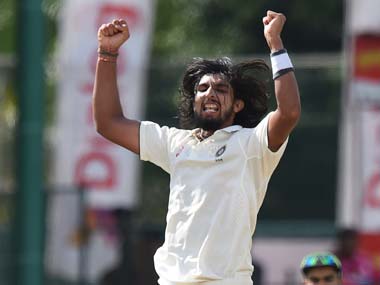Only three days of play completed. Just 160 overs bowled and 110 overs lost (assuming 90 overs a day) and yet no one would bat an eyelid if we get a result at the SSC Colombo on day four. On Sunday, a whopping 15 wickets fell in just 65 overs. Who said Test cricket isn’t exciting? Here are three things we took away from an action-packed third day of the third-and- deciding Test between India and Sri Lanka: Ishant’s star turn Unlike the struggling India top-order, Ishant Sharma’s eyes would have lit up when he saw the green top at the SSC. He had to wait to wait until the third morning to have a go at the Sri Lanka batting line-up, but then produced extended spells of disciplined bowling that has all too often been lacking from him. Well, disciplined in terms of line and length – he overstepped seven times in the innings, taking his tally of no-balls past 20 for the series. [caption id=“attachment_2413960” align=“alignleft” width=“380”]  Ishant Sharma celebrates. AFP[/caption] That hiccup aside, Ishant picked up his seventh five-wicket haul. He hit the right lengths consistently and troubled the southpaw-heavy Sri Lanka line-up with the ball that angled away from over the stumps. He got the opener Upul Tharanga and vice-captain Lahiru Thirimanne caught at slips with the ball that bounced from a good length. But the best was reserved for Angelo Mathews, who got a ball that seamed away from a good length. Ishant, and the rest of the attack, may have been guilty of bowling too short to the tail-enders (more on that later) but then made the crucial breakthrough to dismissed the dangerous Kusal Perera by going fuller with his length again. Ishant’s five-for on Sunday was just reward for his excellent form throughout this series. He sparked Sri Lanka’s collapse in the second Test and is in probably the best form he has shown since breaking on to the international scene in Australia with that spell to Ricky Ponting in Perth, 2007. In 12 Tests since the start of 2014 (including the match at the SSC), Ishant has taken 48 wickets at average 30.95 and a strike-rate of 53. He has also taken four of his seven five-wicket hauls in that span. Those are significantly better than his career numbers –197 wickets at an average of 36.9 and a strike-rate of 65.6. Ishant continues to maintain he’s not a strike-bowler for his team, which is fair enough, But what he is becoming is a much more dependable fast bowler who will get his captain the wickets with the new and old ball. Not since Zaheer Khan at his peak has India had a bowler who can do that on a consistent basis. Dhammika Prasad has been Sri Lanka’s Mr. Dependable If you watch Prasad bowl, you’d probably dismiss him as a gentle medium pacer – a steady run-up, short and stocky frame, and gentle delivery stride. But underestimate him at your peril, as the India opening batsmen have discovered in this series. Four times in four innings he has dismissed one of India’s opening batsman in the first over of the innings. He also dismissed Stuart Binny with the first ball after lunch on Day Two. For Prasad, there is no concept of a loosener. He is at it from the word go. On Sunday, Prasad got hit on the gloves by a nasty bouncer from Ishant. He retired hurt, then came back in the end to play a boundary-filled cameo with a plastered left hand to go along with a neck injury he seemed to pick up on the first day. But when he ran into bowl the first over of India’s second innings, the pain didn’t seem to matter. He bowled Cheteswar Pujara – who carried his bat in the first innings –second ball with quite possibly, the ball of the series. Pitching on a good length in line with middle-stump, the ball seamed away and squared Pujara up before beating the outside edge and clipping the top of middle-stump. Quite simply, unplayable. India’s tail of woe Ah, India’s age old enemy in Tests – the tail-enders. “Have a look at India’s performance (in the past). Since 1932 when India played its first Test, they have struggled to get the bottom five, who add 200 runs to the total. It’s nothing different,” Sunil Gavaskar had said after India let Dinesh Chandimal turn the first Test in Galle on its head. India’s tendency to let the opposition tail wag is now very much a part of cricketing folklore. It happened in Brisbane last year – over 200 runs by Australia’s last four batsmen. Joe Root and company added 150 plus runs at the Oval. Brendon McCullum’s epic 300 in Wellington came after New Zealand had lost five wickets for less than 100. The bowlers’ lengths become way too short or way too full. The bouncer count soars and the helpless shake of the head by the captains become more prominent. Add dropped catches to the mix and voila , the perfect recipe for letting the game get away. On Sunday, KL Rahul, who is having a forgettable Test, dropped a sitter in the slips off Kusal Perera, when he was on nine. The score was 63 for 6. Perera went on to make 55. From looking at a possible 200-run lead, the counter attack from Perera and Rangana Herath brought the lead down to 111. Which, with the scoreboard reading 21 for 3 at the end of third day’s play, looks a whole lot less daunting.
Unlike the struggling Indian top-order, Ishant Sharma’s eyes would have lit up when he saw the green top at the SSC, Colombo
Advertisement
End of Article


)

)
)
)
)
)
)
)
)



